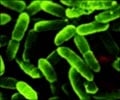A new study has revealed how E. coli gut bacteria in chickens can easily pick up the genes required to evolve to cause a life-threatening infection.

‘E. coli is a common bacterium that lives in the intestines of most animals, including humans. It is usually harmless when it stays in the gut, however it can become very dangerous if it invades the bloodstream, causing a systemic infection that can even lead to death.’





The team of scientists, led by the Milner Centre for Evolution at the University of Bath, sequenced and analysed the whole genomes of E. coli bacteria found in healthy and infected chickens bred at commercial poultry farms to better understand why and how these normally innocuous bugs can turn deadly. They found there was no single gene responsible for switching a harmless bacterium into a pathogenic one, but rather that it could be caused by several combinations of a diverse group of genes.
Their results indicate that all bacteria in chicken intestines have the potential to pick up the genes they need to turn into a dangerous infection, through a process called horizontal gene transfer.
Horizontal gene transfer enables bacteria to acquire new genetic material from other bacteria nearby. This can happen by scavenging DNA molecules from dead bacteria; by exchanging strands of DNA by having 'bacterial sex' or by getting infected by viruses which transfer DNA from one bacterium to another.
Professor Sam Sheppard, from the Milner Centre for Evolution at the University of Bath, led the study. He said: "Previously we thought that E. coli became pathogenic by acquiring specific genes from other bugs, often packaged in mobile elements called plasmids.
Advertisement
"Bacteria do this all the time inside the guts of chicken, but most of the time the scavenged genes are detrimental to the bacteria so it becomes an evolutionary dead end.
Advertisement
"That increases the likelihood of bacteria picking up genes that could help the bacteria survive and turn infectious, or even jump species to infect humans."
The study authors stress the need to monitor strains that are most likely to become pathogenic so can treat them before they become dangerous.
Professor Sheppard said: "We were surprised to find that it's not just a single strain that causes APEC, but any strain can potentially acquire the 'monster combination' of genes needed to turn bad."
Strains with the potential to turn pathogenic could be identified using a similar method to that used to detect variant strains of Covid19. After whole genome sequencing, rapid PCR tests can be used to probe for specific genes that could lead to an APEC infection.
Professor Sheppard said: "We identified around 20 genes that are common in pathogenic bugs and if we can look out for these key genes in a flock of birds, that would help farmers target those carriers before they cause a problem."
Source-Newswise















